Humans and wildlife depend on insect pollinators for the production of fiber, fruits and vegetables. Insect pollinators are required for the pollination of two-thirds of the world’s plants. Bees, butterflies, flies, wasps, moths, beetles and even mosquitoes unwittingly pollinate plants while foraging for nectar and pollen on flowers. In the United States alone, more than 4,000 species of native bees, 750 species of butterflies, 30,000 species of beetles, and thousands of wasps and flies contribute an estimated $29 billion to farm income each year.
Missouri Master Pollinator Steward program
This publication is one in a series that focuses on pollinators and how you can join the efforts to protect them. In addition to these publications, the Missouri Master Pollinator Steward program offers training that includes hands-on activities aimed at building awareness of key pollinators' plight and needs, and inspiring confidence in your ability to make a difference. Learn how you can become a Master Pollinator Steward.
Of all the insect pollinators, bees are the only ones that collect pollen for eating. As such, bees are responsible for 90 percent of all the world’s pollination. The Food and Agriculture Organization of the United Nations estimates that of the roughly 100 crop species that provide 90 percent of food supplies for 146 countries, 71 are bee-pollinated, mostly by wild — native and nonmanaged — bees. Globally, bee pollination is the most valuable ecosystem service provided by wildlife.
Bumble bees, carpenter bees, sweat bees, metallic bees, orchard bees, digger bees, leaf-cutter bees, miner bees, cuckoo bees, mason bees, yellow-faced bees and others are as effective as or more so than honey bees in pollinating fruits and vegetables. For example, one blue orchard bee (Osmia lignaria) is more effective than 25 honey bees at pollinating almonds. And for many tomatoes, bumble bees are 40 to 60 times more effective than honey bees, yielding larger fruits. However, with a few exceptions, the contribution to pollination from native and nonmanaged bees remains unaccounted in the economy.
Butterflies, moths and flies also contribute in a noteworthy way to pollination. This publication discusses these pollinators, in addition to native bees. More information on the pollinators of Missouri — including hummingbirds, beetles, wasps and ants — can be found in MU Extension publication M402, Pollination Mechanisms and Plant-Pollinator Relationships.
Bumble bees
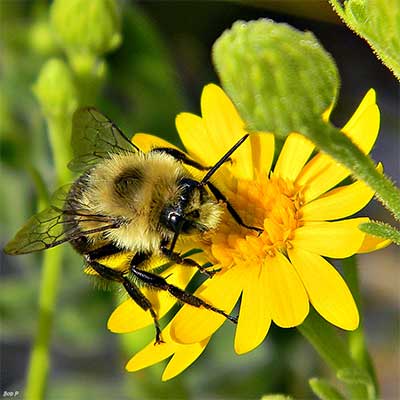
Bumble bees (Bombus spp.) belong to the family Apidae and comprise a group of about 250 species found primarily in temperate regions throughout the world (Figure 1). They are considered to be generalist foragers and usually feed from a variety of plant species.
Adult bumble bees are typically larger and more robust than other types of bees. Their entire body is usually covered with dense black and yellow hairs, but a few species are marked with orange hairs. The tip of a bumble bee’s abdomen is rounded. The ovipositor is a modified stinger found on females. It is not barbed, so they can sting multiple times. However, bumble bees are generally not considered aggressive and only become a problem when their nests are threatened or disturbed, especially if their nests are located near areas of high human activity.
Bumble bees undergo a complete metamorphosis and have four life stages: egg, larva, pupa and adult. Like honey bees, a queen bumble bee lays fertilized and unfertilized eggs. The fertilized eggs develop into females: either workers, which are sterile females with 8- to 16-millimeter-long bodies, or new queens, which are fertile females 17- to 23-mm-long bodies. Unfertilized eggs develop into males, which are fertile drones with 12- to 18-mm-long bodies.
Note: Certain measurements in this publication are given in millimeters because small measurements are more easily expressed in millimeters than in inches. One millimeter (mm) is less than four-hundredths of an inch (1 mm = 0.03937 inch).
Like honey bees, bumble bees are eusocial organisms. They live in colonies whose members comprise different castes, or subsets of individuals, based on the tasks they perform. For example, a single queen heads a bumble bee colony. But unlike honey bees, only a mated new queen hibernates throughout the winter. In the spring, the queen becomes active and begins searching for a suitable, protected nest site. Such sites may be located in an underground cavity, such as an abandoned rodent nest or empty space under roots of decaying trees; under a mass of vegetation, such as bundles of hay or straw; or in hollows in decaying logs. After establishing a nest, the queen uses pollen paste to form a container-like structure called a cell. She lays eggs in the cell and then seals the cell with wax. The developing larvae initially feed on the pollen paste. Later, the queen feeds them through a hole in the cell. Eventually, these individuals will emerge as workers and assume the responsibilities of constructing more cells and taking care of later broods. Workers use wax, secreted by their abdomens, mixed with pollen to construct oval cells in which nectar or pollen is stored. In other cells, the queen lays eggs (several per cell), and the workers feed the developing larvae honey and pollen.
Similar to honey bee workers, bumble bee workers forage for nectar and pollen and have a large flat structure on their hind legs, called the corbicula, used to collect large amounts of pollen during their foraging trips. Workers live for about a month.
Colony size varies among species and the time of year. At its peak, a nest may contain from 50 to 400 bees.
Toward autumn, the queen shifts production from workers to reproductives, and begins to lay eggs that will produce drones and future queens, called gynes. A few days after emergence, the drones and gynes will leave the nest. Eventually, the old queen and the last of the workers die. Mating among the recently emerged reproductives varies among species. Bumble bees do not swarm like honey bees. Sometimes bumble bee mating occurs near a nest opening as males wait for emerging females. In other cases, the males may gather at various visual markers — such as a flower, rock or fence post — and pounce on any passing females, or they may fly along definite routes searching for females entering the area. After mating (often more than once), the new queen feeds heavily on pollen and nectar, storing the energy as fat inside her body, and begins searching for a site to overwinter. In the spring, she will search out a suitable area to build her nest, and the annual cycle repeats itself.
Natural habitats
Habitats with coarse vegetation and other kinds of natural debris and rodent activity are most favorable for bumble bee populations. Their nests are found under vegetation or debris, in hollow logs aboveground, or in cavities underground. They do not dig their own burrows but seek out abandoned rodent burrows in which to build nests. Areas that appear to be unkempt are best for nesting. Relative to other bees, bumble bees have a long period of summer activity and a small capacity to store resources in their nests, so they require continual access to nearby food sources through the summer. Although they have been shown to fly as far as 10 kilometers (about 6 miles), they do most of their foraging much closer to the nest.
Like other bees, bumble bees do well in habitats containing a variety of flowering plants and a consistent source of water. As a nest is getting established, a bumble bee queen may have to visit as many as 6,000 flowers a day to get enough nectar to produce the body heat required to brood her eggs. The brood cools down while the queen is gone, so her foraging trips need to be short. For this reason, most nests are located near an area with a variety of flowering plants that persist throughout summer.
Bumble bees are better pollinators than other bees for certain kinds of plants because they collect pollen in a unique manner referred to as buzz pollination. During buzz pollination, a bumble bee rapidly vibrates its wing muscles while holding onto the pollen structures of the flower, causing them to release large amounts of pollen onto the bee’s body. These vibrations more effectively move pollen from the blossoms onto a bumble bee’s body for transport to other plants of the same variety. Some kinds of plants — including nightshade, rose and heath families — require buzz pollination for proper pollen transfer. Many crops — such as blueberry, cranberry, tomato and kiwi — belong to these groups and show improved yields from buzz pollination.
Artificial habitats
Artificial nest boxes for bumble bees are composed of two parts: the container and the nesting material. The container can be made of wood, plastic, metal or clay and can be of various shapes and sizes. It must have an entrance hole large enough for a bumble bee to enter and at least two ventilation holes to minimize the accumulation of moisture inside. A tube can be inserted into the entrance hole if the nest is going to be buried later to attract species that nest underground. The ventilation holes should be covered with some kind of fine mesh to keep other insects, especially ants, from getting in through the holes and destroying the nest in the early stages of establishment. A variety of hollow containers can be used to make artificial habitats for nesting bumble bees. For an individual nesting compartment, the recommended volume should be somewhere between 216 and 1,000 cubic inches, or 6-by-6-by-6 inches and 10-by-10-by-10 inches, respectively.
The best nesting materials to place inside the container include dried moss, upholstery stuffing, wool, horsehair or old mouse- or bird-nest materials. Synthetic fibers and cotton stuffing should be avoided because they will entangle and kill the bees. Place a wad of nesting material about the size of a tennis ball inside the container so that it does not touch the sides of the container and air movement is possible. Make a small depression in the ball so it is slightly concave on one side. Situate the ball so the concave side faces the nest entrance. Rodent droppings placed inside nest boxes are often attractive to bumble bee queens. The queen will begin rearranging things slightly when she enters the cavity.
Bumble bee boxes should be in place in suitable areas by early spring. Different species have their own preferences for nest location, but most prefer locations that are sheltered from the wind and out of the direct sun. Nest boxes can be placed under sheds, shrubs or debris, or buried in the soil. Success rates for use of artificial nest boxes each year ranges from about 3 to 30 percent, so place more boxes than you think you will need. Use of a nest box is often related to where it is placed and whether mice have used it as a nest. Being used by mice is often a good sign that a box is in a good location and that bumble bees will use it later.
Bumble bees and greenhouse tomatoes: A dynamic duo
Greenhouse tomato producers face a unique challenge. Tomatoes are self-pollinating plants with flowers that need to be shaken so their pollen will drop. Outdoors or in a small open-sided greenhouse, a breeze may provide enough motion to cause pollen drop. But in massive high-sided greenhouses where tomato plants are grown up to 12 feet tall, there is no breeze throughout.
To overcome this challenge, tomato growers have used pollen vibrators, leaf blowers, and strings that are tied to the plants and shake the flower clusters when tapped. Of these tools, the pollen vibrator, which is similar to an electric toothbrush, provides the most consistent results. But it also requires that someone walk through the greenhouse daily to buzz each flower cluster. By spending less time manually buzzing flowers, tomato growers can save on labor costs.
How bumble bees became partners of greenhouse tomato growers
Enter the “humble bumble,” one moniker applied to bumble bees. The use of bumble bees in crop pollination, slow in coming, was first seen as having promise by Frederick W. L. Slader in his 1892 book The Humble-Bee, Its Life History and How to Domesticate It. For the next 60 to 70 years, bumble bees were recognized as helpful pollinators of crops such as red clover, and during that time, were introduced in countries such as New Zealand and Chile. By the 1960s and ’70s, research had begun on how to produce colonies consistently, with studies focusing on such aspects as queen production, mating, hibernation, and colony initiation. A breakthrough occurred in 1985 when carbon dioxide was determined effective for artificially ending diapause, a resting state when no development occurs, resulting in the ability to produce colonies year-round.
Within a year, Roland De Jonghe, a medical doctor in Belgium, and his associate, Frans Baelus, tried using Bombus terrenstris for pollinating greenhouse tomatoes, and an industry was born. De Jonghe became the founder and principal owner of Biobest Industries (now Biobest Group), which sold the first colonies commercially beginning in 1987. Now more than 10 companies sell bumble bees around the world, with greenhouse tomatoes driving the demand and more than 1.4 million colonies being sold annually.
Several Bombus species — atratus, Canariensis, huntii, ignites, impatiens, occidentalis and terrenstris — are used for greenhouse pollination. The first testing in the U.S. was done in the early 1990s by R.C. Plowright and P. Stickles, using Bombus impatiens and B. occidentalis. Concerns arose about accidentally introducing nonnative bumble bees into areas where colonies are used. These concerns have been addressed by the development of native bumble bees for regional use. For instance, B. huntii is used in western Canada, B. impatiens in the U.S. east of the Rocky Mountains, B. atratus in South America, and B. ignites in Japan.
The colony box
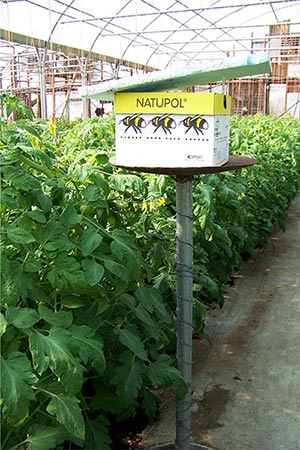
Bumble bee colonies are shipped to growers in colony boxes that contain a supply of sugar water meant to last the total life expectancy of the hive. These maintenance-free hives are made of solid, recyclable cardboard with a moisture-resistant coating. The box has two flight openings: a standard opening for use under normal conditions and a secondary opening with a tapered tube attached to create a locked system. When the standard opening is closed and the secondary opening is in use, the bumble bees can enter but not exit the box. The ability to prevent the bees from exiting the box is useful when the hive needs to be removed from the greenhouse or closed for pesticide applications.
One supplier provides a high-tech colony box, sold as a Wireless Beehome, that is primarily for use during low-light winter periods, especially when artificial lighting is used to increase plant growth. This artificial lighting alters the ultraviolet light spectrum, which bumble bees require for proper orientation. The Wireless Beehome stays closed until the light levels are correct, which not only improves the pollination performance but also increases the development and lifespan of the colonies.
How this partnership benefits consumers
Today, bumble bees play a key role in reducing the cost of growing greenhouse tomatoes. They also improve the ecological impact of greenhouse tomato production in several ways, including by encouraging reduced pesticide use. In the early 1990s, before the use of bumble bees, the percentage of the fresh tomato supply in the U.S. that came from greenhouses was negligible. By 2005, greenhouse tomatoes represented about 17 percent of the U.S. fresh tomato supply and about 37 percent of the fresh tomatoes bought in U.S. retail stores.
The tomatoes produced in greenhouses using bumble bees for pollination require less pesticide use. They are also of higher quality — in taste, size, ripeness and uniformity. This partnership has made possible the development of certain new varieties, such as more intensely sweet cherry tomatoes.
Bumble bees and greenhouse tomatoes: A case study
Jefferson City, Missouri, has a successful greenhouse operation that has been producing tomatoes for many years and has been doing so in partnership with bumble bees since the 1990s. As happens with any new process or technology, Trinklein Brothers Greenhouses (TBG) faced a learning curve when they first introduced bumble bees into their greenhouses. But they persisted and have benefited from the bees’ presence.
Problems that had to be addressed
Raccoons tore holes in the plastic and destroyed hives to get to the honey. To address this problem, TBG replaced the plastic ends of their greenhouses with fiberglass and also placed the hives on steel poles wrapped in barbed wire to keep varmints from attacking the hives.
Ants are a continuous problem and can weaken a hive and destroy it over time. TBG applies grease or some other sticky substance to the steel poles to prevent ants from reaching the hives.
The bees have trouble finding their way back to the hive once the tomato plants have grown to over 8 feet tall. TBG’s pollinator supplier recommended tying a ribbon or other shiny object above each hive at the height of about 10 feet to help bees find their way back to the hive, and doing this seems to help.
Cost and lifespan of a hive
A hive currently costs about $100, down from a cost of about $300 initially. Freight is about $30 per hive. TBG’s hive supplier provides care instructions and replaces any hive that does not perform well.
TBG currently uses four hives for its 10-bay gutter-connected range, which has 30,000 square feet of production and has been in use for 15 years. They plant two crops: a spring crop that finishes in June/July and a fall crop that is planted in August and finishes in early December. The spring crop produces about twice the fall crop, and an annual yield of 30 pounds per plant is considered good.
A hive has a useful life of about 10 weeks, which is sufficient for the fall crop, but the spring crop requires a second hive as the first declines. Thus, 12 hives pollinate 5,400 tomato plants that produce about 160,000 pounds of fruit. TBG estimates that each hive saves about $300 in labor (remember, the cost of each hive is $130 including freight), so TBG’s sees a savings of about $2,000 annually.
Working with the bees
TBG employees have adapted quite well to working with the bees. One noted being stung only once in 15 years. Stings usually only occur when an employee grabs a bee while fruit pruning or removing leaves.
In an operation of TBG’s size, hand pollination would require several workers to vibrate plants at the same time when pollen is being shed in abundance. Hand pollination is among the most boring tasks associated with tomato production, so it easy to convince oneself to skip pollination once in a while. Bumble bees, however, are eager and reliable pollinators.
The presence of bumble bees usually results in increased fruit set and size, but TBG said they also see less ribbing, which they attribute to more seeds and hence more pulp being present in each fruit.
TBG has tried to reduce insecticide use since introducing bumble bees. Recently, they have faced fungus problems, but luckily the bees are tolerant of fungicides. They do, of course, close the hives when applying any pesticide.
Mason and other solitary bees
A mason bee is a type of solitary bee belonging to the genus Osmia in the family Megachilidae. They are called mason bees because they use mud in the construction of nest compartments. There are about 300 species of Osmia worldwide, with most occurring in the temperate regions of the Northern Hemisphere. Some common species found in North America are the orchard mason bee (O. lignaria) and the blueberry bee (O. ribifloris). These bees do not produce honey or wax.
Physically, mason bees are about the same size as a honey bee worker and fairly stout-bodied. They are usually metallic blue-black or green. Although referred to as stingless bees, females do have a stinger, but they are not very aggressive and will sting only if provoked.
Unlike honey bees and bumble bees, mason bees are solitary rather than social. They do not live in colonies. Every female is fertile, and each builds and provisions her own nests. No worker or queen individuals are associated with the nests.
In the early spring, males emerge first from nests. They remain near the nests waiting for the females to emerge. After mating, the males die. The females do not build nests but instead search for nesting sites, which usually consist of a narrow hole with a tubular cavity. In the wild, mason bee nests are found in hollow plant reeds, woodpecker drillings, or cracks or holes in wood created and later abandoned by wood-boring insects. Once a female has located a suitable nesting site, she begins to visit flowers to gather pollen and nectar. At the back of the nest, she forms a pollen and nectar provision mass. Once the provision mass is complete, she lays an egg on it and seals the cell with a partition of mud. This mud also serves as the back end for the next cell formed. She then forms another provision mass on top of the mud seal and, in sequence, repeats the process until the cavity is filled. A nest usually consists of four to 10 cells. Some species line the nest burrow with flower petals. Once a female has finished a nest, she plugs the entrance to the tube. She may then seek another nesting site to provision. An adult female lives four to six weeks and may produce four to five nests during the season. Although considered a solitary species, mason bees are not territorial and will readily aggregate and build their nests next to each other. This trait is why they easily accept the closely aligned hollow tubes found in easy-to-build bee hotels.

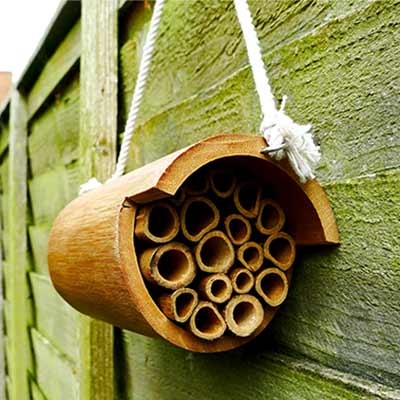
Like all other types of bees, mason and other solitary bees undergo a complete metamorphosis and have four life stages: egg, larva, pupa and adult. By the end of the summer, the developing larvae in the cells have completed their development and enter the pupa stage. Each adult hibernates inside its insulated cocoon and cell throughout the winter and emerges in the spring, when the process of mating and nesting is repeated.
Mason bees and the closely related leafcutter bees (Megachile spp.) are similar in many ways. For example, they both carry pollen by a hair cluster, called a scopa, located on the underside of their abdomen (as opposed to the corbiculae on the hind legs of honey bees and bumble bees), and they both nest in existing holes. When building their nests, however, leafcutters line the cavities with cut leaves, whereas mason bees use clay or mud.
Mason bees forage in cool — as low as 54 degrees F — and cloudy weather, making them excellent pollinators of spring crops.
Natural habitats
Mason bees build protective mud cells inside small tunnels within wood or hollow stems of plants. The openings of the tunnels must be of a certain diameter for the bees to accept them and build mud walls and lay eggs inside. These bees do not make their own tunnels but must locate holes that have been made by some other creature. Natural habitats that contain a wide variety of dead and decaying wood and plants provide the best situations for them to locate holes. Unkempt areas with dead trees and woody plants are good natural habitats for mason bees.
Mason bees are not picky feeders and will use pollen and nectar from a wide variety of flowering plants as food. Natural habitats containing an abundant supply of nearby blossoms that are available from early spring through fall are best for maintaining large populations. These bees do not range far in search of food, so blossoming plants typically need to be within the length of a football field from a nest site. A single species of plant with a long bloom period or several species of plants with nonoverlapping shorter bloom periods can provide enough food to sustain a healthy population. Mason bees also need small amounts of moist soil to form the mud cells in the tunnels.
Artificial habitats
There are numerous ways to provide artificial nesting sites for mason bees (Figure 2). The necessary element is really just a 5/16-inch diameter tubular hole. The presentation, arrangement or design of these holes can vary greatly. Some of the more commonly used designs are wooden blocks with holes and bundles of cardboard tubes.
Welcome native Megachilid pollinators with a bee hotel
A bee hotel is a structure you can put in a garden or orchard to provide a nesting site for native mason and leafcutter bees (Figure 2). It provides small cavities, which these bees prefer for nests. A bee hotel can take many different forms, from a hanging bundle of cardboard tubes to a piece of wood drilled with small holes. You will be able to see where bees have nested in your hotel by looking for cavities that have been sealed with mud. Because mason and leafcutter bees are solitary, they are unlikely to sting you while you watch them at work.
Visit the bee hotels link in the Resources section to learn how to build a bee hotel.
A wooden block nest is made from an untreated wood block of any shape and size. Holes 5/16-inch in diameter are drilled at least 4 inches deep into the block but do not penetrate it, leaving 1/2 inch of wood at the back of the holes. The center of each hole is 3/4 to 1 inch from the center of the next hole. Most wooden block nests have uniformly spaced holes drilled in some kind of pattern, although this is really done only for appearance, as a random pattern of holes would likely suit mason bees just as well. The top of the wood block has some kind of overhanging element that acts as a roof to shield the wood and holes from rain. Also, some kind of hanger is normally attached to the block so it can be secured to a post or other upright object. Wooden blocks can be used year after year — the bees clean out the holes themselves — but parasitic mite infestations are less likely if new wooden blocks are provided each year.
Cardboard tube nests are also used by some mason beekeepers. In some applications, cardboard tubes serve as the lining inside the holes of a wooden block nest. The inside diameter of each cardboard tube needs to be 5/16 inch, so the drilled hole needs to be slightly larger than 5/16 inch to accommodate the tube. In other applications, a bundle of cardboard tubes or hollow reeds can simply be placed inside a larger diameter tube or PVC pipe with a capped end. The larger tube holds the smaller tubes together and protects them from the elements. These applications are more hygienic than reusing an unlined nesting block each year. The cardboard tubes containing mason bee larvae can be easily removed each fall after the active season. The next spring, new tubes can be inserted.
Nesting blocks and tubes do best when placed in an area with water and a variety of mature trees, shrubs and vegetation nearby. Maples are an especially good tree to locate nesting sites near due to their spring pollen production. Try to locate a site that is protected from prevailing winds. If possible, mount the blocks at least 3 feet above the ground on a vertical surface facing in a southeast direction to receive morning sunlight. Once nesting begins, do not move the blocks. After activity has stopped, carefully move the blocks to protected locations for the winter. In the spring, return the blocks to areas of pollination.
A bee or not a bee?
There are two kinds of insect pollinators that are often confused with bees: flies and wasps. In fact, many flower-visiting flies are bee and wasp mimics. By mimicking bees and wasps in appearance, they gain protection from predators. So, how do you tell these pollinators apart?
Fly identification. Flies have only one pair of wings, while bees have four wings. Flies have short and stubby or feathery antennae and sucking or sponging mouthparts. Many flies have huge eyes that almost meet at the top of their heads.
Wasp identification. Wasps have four wings, chewing mouthparts, a stinger in females, and long antennae. While bees usually have hair on their body and legs, most wasps are smooth and almost hairless. Wasps have a typical slender “wasp waist” and do not have pollen-carrying hairs. Wasps are important predators of many insect pests, including cutworms, hornworms, aphids and grasshoppers. Certain wasps make paper nests that hang from a tree or building; bees do not.
Now that you know how to tell the difference between bees, wasps and flies, try identifying the insects in the photos below. See answers below.
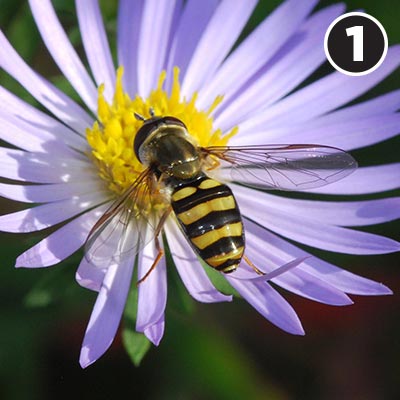
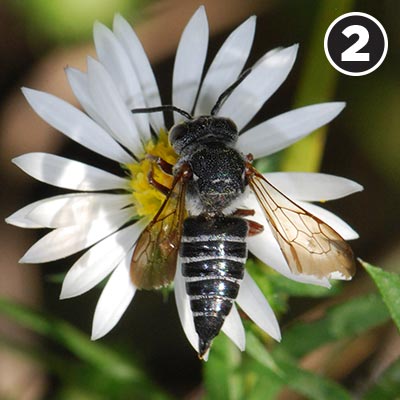
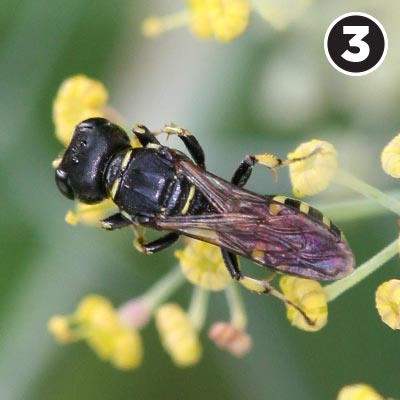
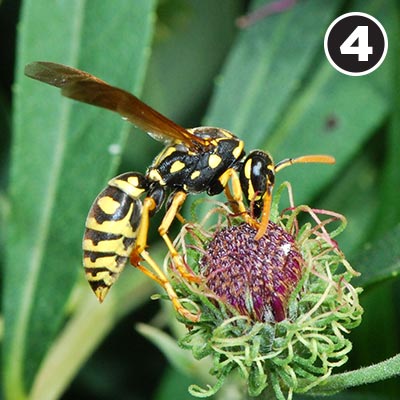
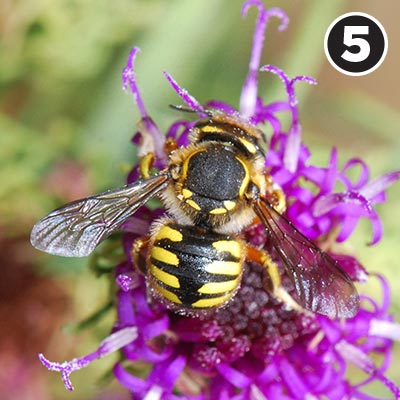

Butterflies and moths
Butterflies are probably the most recognizable type of insect. They and moths belong to the order Lepidoptera and, worldwide, there are about 180,000 described species. These insects have two pairs of large membranous wings that are covered with tiny overlapping scales. Wing color is due either to the scales being pigmented, meaning one color per scale, or to the scales’ surfaces being microsculptured in such a way that light is refracted, which results in wings of beautiful iridescent hues. In general, butterflies hold their wings upright, perpendicular to the body axis, whereas moths often hold their wings flat over the body. The wingspan ranges from 3 to 300 mm, but for most species is less than 75 mm. Butterflies are almost exclusively day-flying, and most moths are active at night or dusk. Moth and butterfly bodies are usually covered in hair and are somewhat elongated and cylindrical. Their legs are long and slender
Butterflies and moths undergo complete metamorphosis and have four life stages: egg, larva, pupa and adult. Depending on the species, there can be one to multiple generations a year. Caterpillar is another term for the larval stage of butterflies and moths, and those of most species are plant feeders. Caterpillars have chewing mouthparts, and many species feed on specific plants. Some caterpillar species are serious pests of cultivated plants. Adult butterflies and moths do not have chewing mouthparts but rather have a tubular mouthpart called a proboscis, through with they suck liquids, such as nectar and honeydew. The proboscis is elongated when being used and coiled when at rest.
Because butterflies and moths fly from flower to flower seeking nectar sources, they invariably come into contact with the flower’s pollen. But lacking specialized structures on their bodies for collecting pollen, such as honey bees and bumble bees have, they are not efficient pollinators.
Butterflies are attracted to a flower by its color. They prefer brightly colored flowers that are pink, red, orange or yellow, and sometimes blue. They also favor flowers that are upright and provide a landing platform from which to feed. These frequently visited flowers often produce ample nectar from deeply hidden nectaries. Moths, being primarily active at dusk or night, are not attracted by color. Instead, they are usually attracted to flowers with a strong sweet odor. Moths can also gather nectar from deep nectar tubes, but they do so on the fly because they do not have to land on a flower to feed.
Common Missouri butterflies
Missouri’s rich diversity of butterflies is based on its variety of natural habitats (forests, prairies, swamps, glades) and its central location in the United States. A total of 198 species of butterflies has been recorded in the state. Butterfly families are commonly named for unique body parts or dominant colors that distinguish them from the other butterfly groups. Distinctive types of behavior and specific caterpillar food sources also help set apart the different families. Brief descriptions of a few of the larger and showier common butterflies follow.
Swallowtails
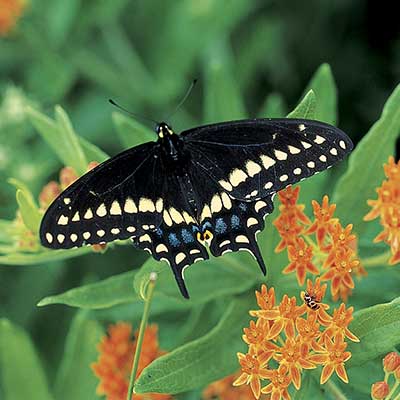
Swallowtails (family Papilionidae) are large, brightly colored butterflies that have a well-developed wing appendage (“tail”) extending from the rear edge of each hindwing (Figure 3). This conspicuous appendage is not usually found in other butterfly families. Swallowtails presumably were given their common name because their “tails” reminded people of the long, pointed tails of barn swallows. One species, the pipevine swallowtail, feeds on pungent vines that make it distasteful to predators. Other similarly-colored swallowtails may gain protection from predation by resembling or mimicking the appearance of the pipevine swallowtail.
Swallowtail caterpillars also display protective adaptations. The adults have large spots that appear as eyes of a larger animal, and the caterpillars have retractable Y-shaped organs (osmeteria) behind their heads for protection. When disturbed, the caterpillar extends this organ, which emits a foul-smelling chemical and scares off predators because of its appearance.
“Brush-footed”
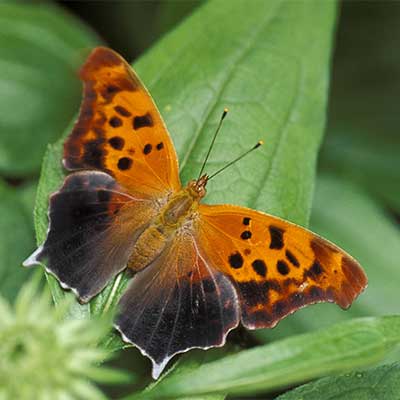
All members of this large and diverse group of butterflies (family Nymphalidae) are so named brush-footed because of the relatively shortened front pair of legs compared with the other two pair (Figure 4). The stunted front pair of legs is useless for walking and is somewhat hairy or brushlike in appearance, hence the family name. The caterpillars typically are spined and darkly colored, and many feed only at night. The brushfooted adults commonly have orange coloration, are active fliers, and feed on a wide array of food sources such as flowers, tree sap, animal wastes, and rotting fruit.
“Whites” and “sulphurs”
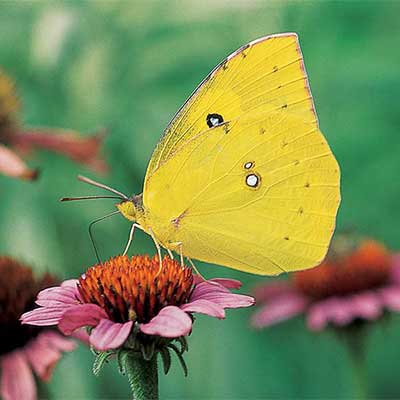
A widespread group of butterflies named for their color is the white and sulphur family (family Pieridae) (Figure 5). These butterflies are principally white, orange, or yellow, with blackish markings and borders on their wings. The word butterfly was used to describe the yellow color of common European sulphurs. The larvae of the common white European cabbage butterfly, which was introduced into North America, feed on cabbage and related plants and are considered a pest species. Native sulphurs are common in fields and yards, where the larvae feed on clovers.
“Blues” and “hairstreaks”
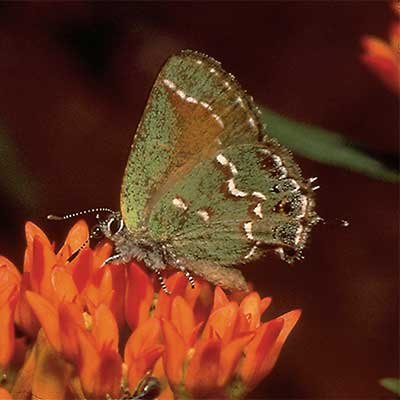
Small butterflies that are commonly blue and gray are called blues and hairstreaks (family Lycaenidae) (Figure 6). Some members of this butterfly group appear as small versions of swallowtails. However, these small butterflies have only thin, hairlike extensions projecting from the hindwings, not the wider, more developed wing extensions of swallowtails. At rest, blues and hairstreaks characteristically hold their wings folded over their backs. In this posture, patches of orange that decorate many species can be observed. Birds often strike color patches or tails, mistaking them for butterfly heads and allowing the butterflies to escape. Some caterpillars of this family produce a sugary substance called honeydew that is “milked” from the caterpillars by ants. In return for this honeydew, the ants protect the caterpillars from predators. The adult butterflies of this family are seen around flowers growing along roadsides, in fields, and in other open areas.
Skippers

Another group of small butterflies is easily identified by a swift, bouncing, and erratic flight. This “skipping” flight pattern gives this group the name skippers (family Hesperidae) (Figure 7). These little butterflies are generally brown, orange, or black. If you get close to a skipper, you will see that it has a stout body. Although all butterflies have clubbed antennae, skippers have distinctive hooks at the ends of their antennae.
Milkweed visitors
Milkweed butterflies belong to the subfamily Danainae, in the family Nymphalidae. Historically, this group had been considered a separate family, Danaidae. These butterflies get their name from feeding on milkweed plants. The caterpillars are apparently immune to the toxic juice of the milkweed and consume it voraciously. Thus, both the caterpillars and adults are distasteful to predators such as birds. The monarch butterfly is the most common and familiar milkweed butterfly and is easily recognizable by its bold orange and black color (Figure 8). (The viceroy, a brushfooted butterfly, resembles the monarch but is smaller and has a black line across the hindwing. Male monarchs have an enlarged, dark spot in the middle of each hindwing that give off a scent to attract females.
Although many insects migrate, the long-distance butterfly champion is the monarch. Each fall, Missouri monarchs join others that have come from as far away as Canada and migrate south to a small pine fir forest 75 miles west of Mexico City. This migration is truly one of the greatest natural phenomena in the world. Not only is it a miracle that this butterfly (weighing only about half a gram, less than two-hundredths of an ounce) migrates more than 2,000 miles, but no one knows how the 100 million monarchs find this overwintering ground when none of them has ever been there before. The migrating individuals are about five generations removed from the ones that made the trip the previous year.
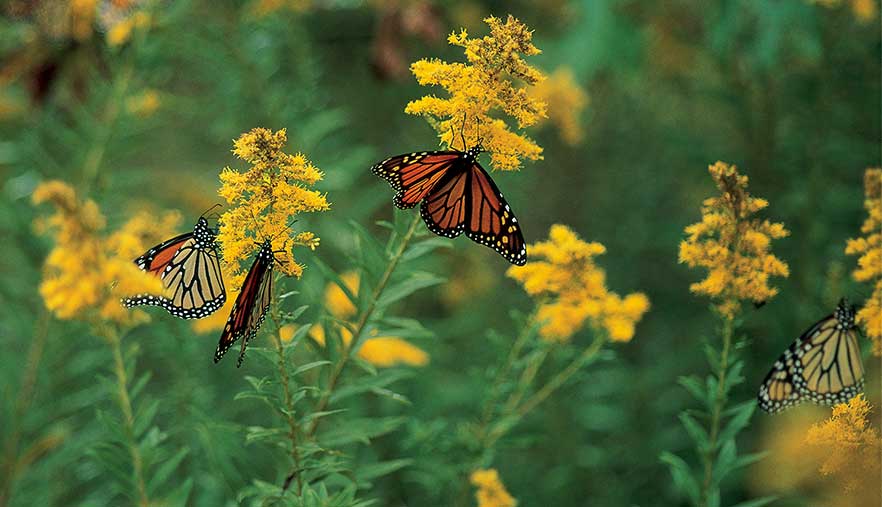
Butterfly houses
Butterfly houses are popular in the U.S. and around the world. The first was founded in 1980 in England with butterflies from the tropics. Now, there are butterfly houses in more than 50 countries. The first U.S. butterfly house was opened in Florida in 1988. By 2017, there were at least four in Missouri and more than 60 in the U.S. and Canada.
The innovation of the butterfly house was to present exotic butterflies within a simulated tropical environment, in the form of a plant-filled, hot and humid walk-through greenhouse in which people of all ages were free to explore. In 1980, the London Butterfly House was opened to the public and became the prototype for the modern temperate-region live tropical butterfly exhibition.
The business structure of butterfly houses varies from being owned and operated by such entities as a zoo, botanical garden or museum, to being an owner-operated small business. Most charge an entrance fee or receive support from such fees.
Seasonal screened structures
Use of seasonal screened structures is another approach to butterfly exhibits. In these, only native butterflies and moths are featured. A garden is generally established to provide a wide range of habitat and food sources. Chrysalides can be brought in from the nearby area to increase the exhibit population. These exhibits generally have three to 15 species and up to several hundred butterflies. Although able to exhibit far fewer butterflies than a true butterfly house, with its year-round controlled environment, a screened structure can be built and maintained at a fraction of the cost.
Common Missouri moths
As with butterflies, Missouri’s diverse landscape and habitats, coupled with its central location in the U.S., makes it home to a diversity of moths. Contrary to public perception, there are many more species of moths than of the closely related and more visible butterflies. Missouri has more than 3,000 species of moths, more than 15 times the recorded butterfly species. Common family names may reflect their similarity to a thing (sphinx, tiger, dagger), an economic product (silk), a trait (clearwing), an associated plant (yucca) or some other association. Most moths fly at night or at twilight, and some are attracted to lights, the latter of which can be monitored with the use of lights. A few of the moth families that are most widely recognized — due to their showiness, novelty, or difficulty as pests — are described below.
Sphinx or hawk moths
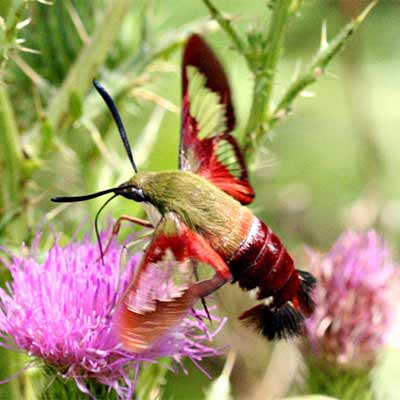
The sphinx or hawk moths (family Sphingidae) are also referred to as hummingbird moths because of their flying characteristics (Figure 9). They are among the largest and most beautiful moths. Their species number more than 800 worldwide, with 56 having been recorded in Missouri. Some species fly during the day, and some are known for their speed, clocked as fast as 30 miles per hour. They have a long, strong tongue and are often seen on tubular flowers. The sphinx name derives from the larvae, which can be several inches long and rear up sphinxlike to rest. Although two species are well-known garden pests, the tobacco and tomato hornworms, most sphinx moth caterpillars are not, and most may be identified by either a horn or a colored spot near the end of the abdomen. These moths often overwinter as thin-skinned pupae on or just below the ground surface.
Tiger moths
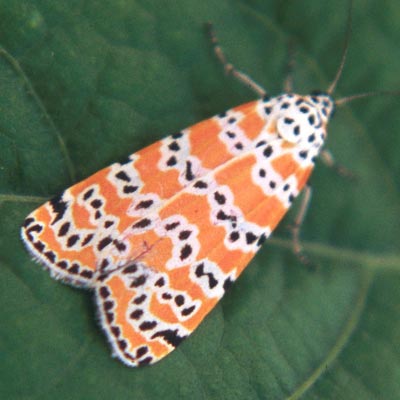
Tiger moths (family Arctiidae) are also referred to as tussock, ctenucha or lichen moths (Figure 10). The common name of woolly bears may also be associated with the caterpillars of several species. The intriguing long, thick hair and color pattern of these caterpillars have led to interesting folklore on the severity of the upcoming winter. These moth species number about 10,000, with 60 having been recorded in Missouri. The color, pattern and size of these moths vary greatly, but their wings are frequently stripped or spotted, suggesting the name tiger moth. Many feed on poisonous plants and produce poisonous compounds. These species have evolved patterns of bright “warning colors,” such as that of the scarlet-winged lichen moth (Hypoprepia miniata). Another novel characteristic of some species is the high-frequency sound they produce in flight, which supposedly warns bats that the moth is distasteful or poisonous. The artistic calico moth is associated with flowers, especially goldenrod. Most species of this family overwinter as fully developed larvae or as pupae.
Owlet, dagger or underwing moths
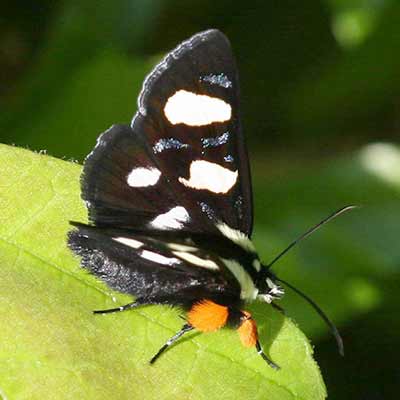
Owlet, dagger or underwing moths are of the huge family Noctuidae, which numbers more than 20,000 species worldwide and more than 700 in Missouri (Figure 11). It is by far the largest family of the Lepidoptera in the state. Most noctuids are medium-sized (0.75 to 1.75 inches) and somber gray or dull brown, with a few exceptions of bright color (for example, green marvel, beautiful wood-nymph and grape epimenis). The colors and patterns of the many moths generally serve to camouflage them by resembling leaves, bark, mosses, bird droppings or bare earth. The bright-colored ones match certain flowers they rest on during the day. An interesting characteristic of these moths is a pair of auditory organs, called tympana, located on the thorax, which allow the detection of high-frequency bat chirping. Once detected, these moths engage in erratic, evasive flight. The adults have well-developed tongues and feed on flower nectar, tree sap, ripe fruit, and animal dung or carrion. The caterpillars are the source of angst to many farmers, with such renowned pests as the army worm, cutworms and cotton boll worm (see MU Extension publication MP401, Insects).
Clearwing moths
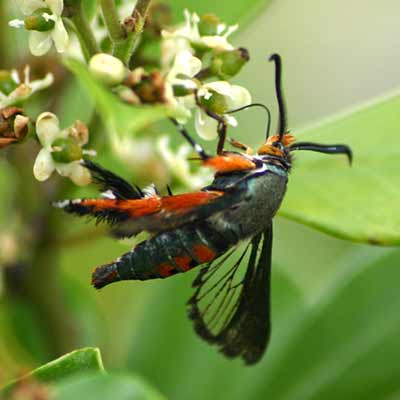
Clearwing moths (family Sesiidae) are also referred to as wasp moths due to their resemblance to bees and wasps (Figure 12). Most species have clear or partially clear wings and bodies that are black or are brown striped with yellow, orange or red. The legs are usually long and wasplike. Their flight is generally characteristic of the bee or wasp they mimic. They feed on flower nectar, sometimes of the same plant for which their larvae are a pest. Some, such as the peach tree borer and squash vine borer, are especially known as pests of orchards, berries and vining vegetables.
Natural habitats
An area containing a wide variety of flowering plants provides excellent habitat to maintain butterfly and moth populations throughout the year. Butterflies and moth caterpillars often depend on having certain kinds of food plants available in their natural environment. The food plants and natural habitat of many butterflies and moth caterpillars are well-known, but there are many species that we are still learning about. Destruction of habitat can have a serious impact on the stability of their populations.
As a group, caterpillars feed on numerous types of leaves, stems, flowers and seeds of plants. Many caterpillar species feed on specific plants and plant parts, but even when they are on their preferred plant, they are often found in specific situations. For example, different species may prefer to be on leaves of a certain age, perched in a characteristic pose, sitting on the top or bottom of a leaf, associated with a certain type of leaf vein, feeding along a certain edge of a leaf, or positioned in a specific cavity or constructed retreat.
The annual peak in butterfly and moth caterpillar abundance is late spring. This is typically when the largest amount of new plant tissue is available to feed on. The peak of activity for a certain species may last only two or three weeks, so there is a shift in which species are active as the year progresses. Caterpillars that feed on mature plants, flowers and seeds usually come along later in the summer. Habitats that provide a variety of plant species that flower and mature at different times of the year provide the best habitat to sustain a diverse population of butterflies and moths.
Giant silkworm moths
Giant silkworm moths are medium- to large-sized. Many have patterns of eyespots on the wings, and some have long tails. Several are our most mysterious or fabled Lepidoptera, such as the luna (pictured below), cecropia and io moths.
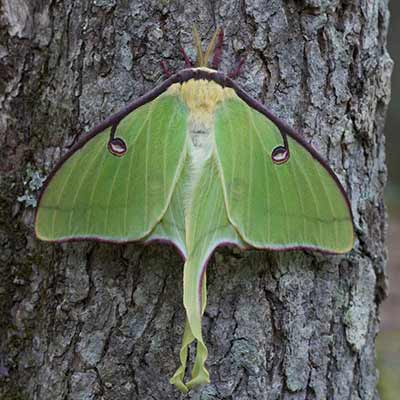
Besides their beauty and size, they have a couple of other notable characteristics. The female moth’s release of chemical substances, called pheromones, to attract males has been especially well documented in this family. In addition, their adult life cycle is very short, two weeks or less on average. With such a short adult span, most species do not feed. Their mouthparts are tiny, and their feeding tube is too short to coil.
Artificial habitats
Rearing caterpillars is an enjoyable activity that is done by children, hobbyists, collectors, students and professional entomologists alike. It is not difficult technically and does not necessarily require special equipment. The most important aspect of rearing caterpillars is providing them with the necessary environmental conditions. Many caterpillars can be successfully reared into adult butterflies and moths just by being provided fresh and acceptable plant material, kept in rearing containers free of mold, and being exposed to favorable temperature and moisture levels throughout development.
A closed container of almost any size will work to rear a small number of many species of caterpillars. For individual caterpillars, a small plastic vial with a lid is often enough. Place an absorptive material such as a piece of dry paper toweling or coffee filter in the container to absorb excess moisture, and punch a few small holes in the lid to help with air circulation. In larger rearing containers, add peat moss as a substrate for tunneling and pupation, and Styrofoam when rearing species that tunnel into wood to pupate.
An appropriate food plant material in the proper stage of growth is necessary inside the rearing container. In general, spring-active species eat new leaves, and summer-active species feed on old leaves. Bright-colored caterpillars are often flower feeders, whereas green caterpillars feed on leaves and stems. If you are unsure about the type of food plant a caterpillar requires, a few general plants can be used as substitutes, including clover, dandelion, dock, fleabane, and romaine or other leafy varieties of lettuce. An oral irrigator, such as a Waterpik, can be used to ensure that plant materials stay fresh.
Another method of rearing large numbers of caterpillars is to place sleeves made of fine mesh or lightweight cloth over branches or whole plants in their natural state. The sleeves can be fashioned in a variety of ways so as to stay closed around the plant materials and keep the caterpillars inside, where they develop on the food plant. Double-sleeving is often needed to protect the caterpillars from birds or predacious insects. When rearing caterpillars that feed on small plants, the plants can be transplanted into a pot and then the entire pot with plants placed inside a sleeve.
Natural enemies of monarch butterflies
Although milkweed-munching monarch caterpillars garner some protection from the cardenolide toxins present in their diet, those toxins do not make them immune to predation, parasitism or disease. In fact, monarchs of all life stages are vulnerable to these threats.
Predators
Only about 5 percent of monarchs are estimated to reach their fifth larval instar. Eggs and small caterpillars face predation by ants, spiders, beetles and lacewing larvae. In a laboratory experiment, one lacewing larva was observed consuming 40 monarch eggs. Immature monarchs also are preyed upon by assassin bugs, paper wasps and Chinese mantises.
During the breeding season, adult butterflies face less danger of predation; however, the risk increases during the overwintering period. In Mexico, birds such as the black-headed grosbeak, black-backed oriole and Scott’s oriole feed on monarchs, as do mice. The western population overwintering in California faces similar predation by the spotted towhee.
Parasitoids
By feeding in or on a host organism, parasitoids eventually cause the host’s death. At least 12 species of tachinid fly, as well as species of chalcid and braconid wasps, are known parasitoids of monarch caterpillars and chrysalises.
Lespesia archippivora, perhaps the most-studied monarch parasitoid, is a tachinid fly that attacks caterpillars. Its young grow within the caterpillar, resulting in its death at later larval instars or inside the chrysalis. Parasitism rates average 10 to 20 percent in the wild; however, rates of 90 percent have been reported at some study sites.
Another parasitoid, Pteromalus cassotis, is a tiny chalcid wasp that lays its eggs inside a monarch chrysalis. As the wasps develop, they feed on the monarch during its metamorphosis, killing it. After a few weeks, adult wasps emerge. The effects of this species on monarch populations is not fully understood. Other than removing monarch eggs and young caterpillars from natural habitats to be reared in captivity, no integrated pest management (IPM) strategies currently exist to prevent such parasitoid-induced mortality.
Diseases
Several diseases — viral, bacterial and parasitic — are known to affect monarch butterflies. Nuclear polyhedrosis virus (NPV), often known as black death, infects monarch caterpillars and chrysalises. Pseudomonas bacteria can be found in soil and on plants, thriving in warm, moist conditions. It can impact caterpillars already weakened by other diseases and is often fatal. However, low larval density in milkweed patches reduces the chance of spreading these diseases between caterpillars in natural habitats.
Perhaps the most-studied monarch disease is a debilitating parasitic ailment caused by the protozoan Ophryocystis elektroscirrha (OE). Infected adult monarchs harbor microscopic OE spores on the outside of their bodies. When spores are left on eggs or milkweed leaves, monarch caterpillars consume them. The parasites then replicate inside the caterpillar and chrysalis.
Although OE is not often fatal, monarchs with severe OE infections can fail to emerge successfully from their chrysalises, either because they become stuck or because they are too weak to fully expand their wings. Monarchs with mild OE infections can appear normal but live shorter lives and cannot fly was well as healthy butterflies.
Studies have revealed that the occurrence of OE is higher in monarchs that do not migrate, such as those found in southern Florida. The year-round presence of tropical milkweed (Asclepias curassavica) — which is attractive, easy to grow, and widely available through commercial nurseries — also may be facilitating the spread of this parasite in some U.S. regions. As an IPM strategy to reduce this spread, it is recommended that tropical milkweed be cut back in the fall when native milkweeds age, gradually replacing tropical milkweed with appropriate native species in landscaped areas.
Fly pollination
The two-winged insects (flies, gnats, mosquitoes) is a very large group. Many of them — such as the Syrphid flies, or flower flies — specifically visit flowers. They are not as hairy as bees or as efficient in carrying pollen, but some are good pollinators (Figures 13–15).
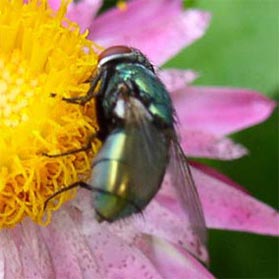
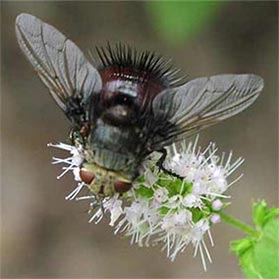
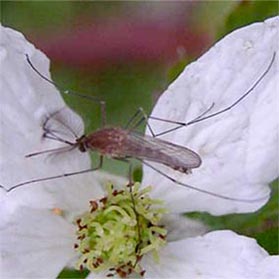
Flies from garbage or dead animal for sale — Really?
Really. Two flies are commercially available: Lucilia sericata, the common green bottle fly; and Calliphora vomitoria, the common blue bottle fly. Although they feed on similar products, the former is strongly associated with garbage and feces, and the latter with rotting flesh. Both are sold for pollination services, with the blue bottle fly also being sold to feed snakes and other reptiles.
The pollination services of these flies are primarily used for seed crops, notably vegetables and flowers. For vegetable and flower seeds to be true to type, they must develop from flowers of the same species that are free of unwanted pollen. Efficient seed production has led to many varieties of the same vegetable or flower species being grown near each other. This proximity makes keeping seeds true to type difficult. To prevent cross-pollination, the plants are put in isolation cages or tents. For insect-pollinated plants, the pollen is restricted from entering on an insect. Seed production in screen-enclosed areas in the open field is common in the western states, where much of this seed industry is located. In these contained areas, flies perform better than bees.
The flies are shipped as pupae inside cardboard tubes. They readily hatch at temperatures above 60 degrees F (15 degrees C) in four to six days. Suggested distribution of green bottle flies is 15 milliliters per square meter, or roughly 1 tablespoon per 10 square feet. Place the pupae in cups protected with a lid, similar to a coffee cup and lid with a drinking hole. Place the cup in shade near the plants. The flies will hatch and fly out.
Blue and green bottle flies are noted for pollinating the following plant families (and example crops): Cruciferae (cauliflower, radish and cabbage), Compositae (sunflower and lettuce), Liliaceae (onions and leek) and Umbelliferae (carrot). Next time you pick up a seed pack of carrots, lettuce, radishes or green onions, remember the role that pollinator flies can play in their development.
Fly flowers
The flowers that are pollinated by flies are typically pale and dull to dark brown or purple. Sometimes they are flecked with translucent patches. The odor they emit, commonly being putrid, like rotting meat, attracts flies. They might also have the smell of carrion, dung, humus, sap or blood. They do not have nectar guides. They do produce pollen, and flowers are often funnel-like or structured as complex traps, helping to ensure that the insect leaving carries pollen with it.
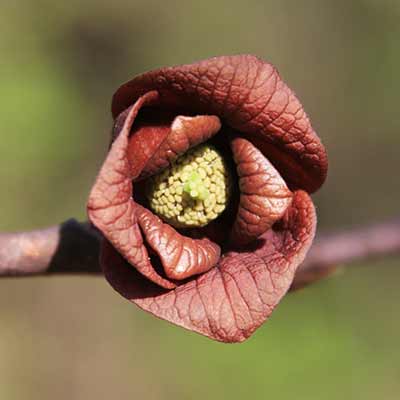
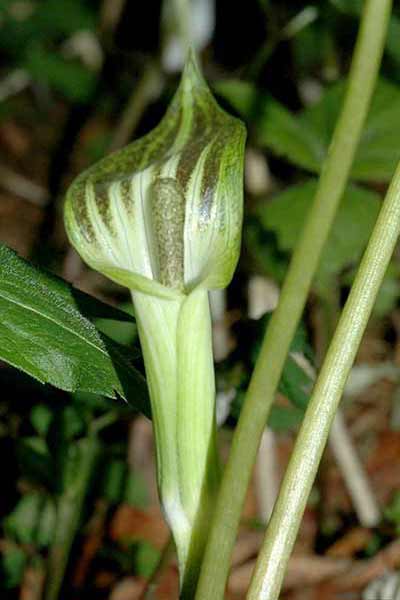
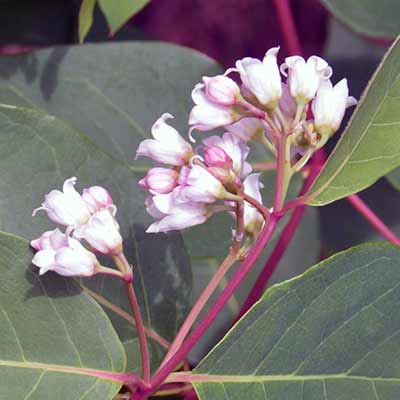
Putrid odor
Putrid smelling blossoms are an adaptation to attract certain fly pollinators (Figures 16 and 17). Even male mosquitoes (relatives of flies) get in on the act, pollinating certain orchids. Long-tongued flies (for example, syrphids and bombylids) feed on the same flower types that bees do. Short-tongued flies feed on flowers that imitate the main source of food for flies. While they feed, flies may be trapped for a time in a flower such as Stapelia, or Dutchman’s pipe.
A fly’s worst friend
Dogbane is a common pink-flowered shrubby herb that flowers in July and August (Figure 18). Dogbane flowers are designed to attract butterflies. When these long-tongued pollinators visit the flowers of dogbane, their tongues become coated with a pollen and cementlike mixture from the flower. Flies and weaker insects are not so lucky. These lightweight pollinators often become glued to the flower and die a slow death from starvation.
Reducing pesticide use to benefit pollinators
Pet owners washing their dogs with flea and tick shampoo; housekeepers scrubbing bathroom fixtures with mold and mildew removal agents; lawn enthusiasts applying granular crabgrass preventers — What do these people have in common? They all are using a pesticide of one type or another.
Some people think pesticides are only used for controlling insects. By definition, a pesticide is any product that kills or repels pests. Pests can include weedy plants or plant diseases, animals such as moles, and even household mildews, molds and bacteria. Therefore, products designed for use as disinfectants, toilet bowl cleaners, insect foggers and even pet flea collars are considered to be pesticides. If you are unsure whether a product qualifies as a pesticide, check the package label for pesticide registration numbers issued by the U.S. Environmental Protection Agency (EPA). Pesticide labels carry two EPA registration numbers: the first number identifies the product’s manufacturer and the second identifies the specific pesticide.
Pesticides serve many purposes around the farm, home and garden. They modify the appearance of lawns by eliminating unwanted plants we consider weeds. They can increase production in gardens and fields by reducing loses caused by insects, diseases and weedy species. They help us keep our living spaces clean and can even protect our health if used properly. Yet, it is important to remember that pesticides are poisons and, when used carelessly, can pose dangers to humans, wildlife, the environment and pollinators. Insecticides in particular are widely recognized as potentially being most harmful to pollinators.
Of the three most used pesticide categories — insecticides, herbicides and fungicides — insecticides are more likely to be harmful to pollinators, as well as other animals, including humans, because their aim is to kill insects, members of the animal kingdom. Pesticides in the other two categories are aimed at members of other kingdoms. Herbicides are used to kill plants, and fungicides are used to kill or control fungus and some bacteria.
Reducing pesticide use in general will benefit pollinators, but reducing or modifying insecticide use, specifically, will provide the most benefit. An example of a commonly overused insecticide is a grub killer applied to lawns, often annually. Sometimes grub killers are applied to repel moles rather than to kill grubs. When applied in early spring for this purpose, they kill earthworms and may harm pollinators. The lack of earthworms, a primary food source of moles, is what causes the moles to leave.
Besides forgoing or decreasing insecticide use, try implementing other insecticide-use practices that cause less harm to pollinators:
- Do not apply insecticides to plants when they are in flower.
- If you need to spray an insecticide on a flowering plant, such as melons or squash, do so in the evening.
- When applying an insecticide to the foliage of a flowering plant, use a spray instead of a dust, if possible.
- When applying an insecticide to a flowering plant, or one that may flower soon, use an insecticide chemical class that is less toxic to bees.
When a beneficial pollinator is also a pest
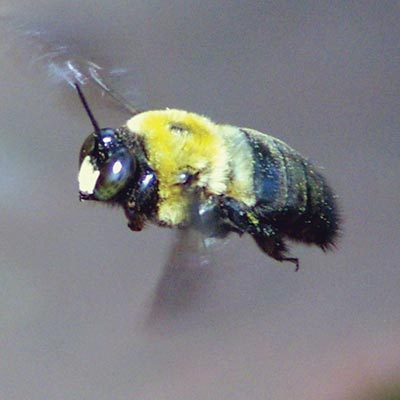
Carpenter bees are one of several insects that are beneficial pollinators but can also be pests (Figure 19). They are fine when in the woods, but not when they start making tunnels in your wooden deck or shed. Painted wood detracts them and so is a nonpoisonous way to deal with them.
Another example highlights how IPM can solve the conundrum of an insect being both a pest and a beneficial pollinator. Large caterpillars known as hornworms feed on tomato plants and can destroy leaves and fruit (Figure 20). There are two species, the tobacco and tomato hornworm (Manduca sexta and M. quinquemaculata, respectively), whose adult phases are the desirable and fascinating sphinx moths, known as the Carolina sphinx moth and the five-spotted hawkmoth, respectively.
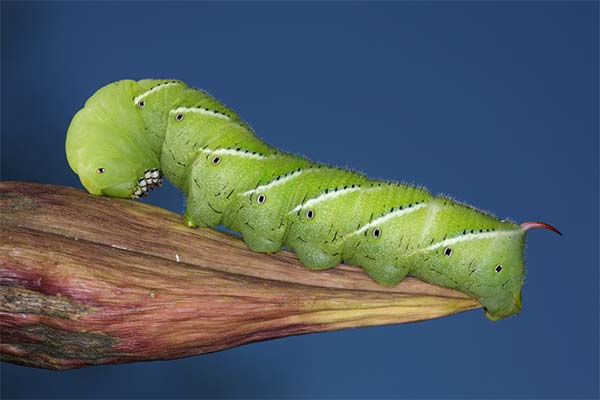
To control this pest without killing pollinators, first, avoid planting tomatoes near flowers that attract sphinx moths. Attracting flowers are generally tubular and strongly fragrant, such as moonflowers, morning glories, Datura species (for example, jimsonweed and devil’s trumpets) and Nicotiana species (aka flowering tobacco). Second, if you spot just a few caterpillars and your tomato patch is fairly small, try hand-picking the caterpillars during early morning hours when they are easier to see (and feed them to your chickens, if you have any — chickens love them). If there are too many to hand-pick and they are under 2 inches long, applying Bt (Bacillus thuringiensis) insecticide is effective and won’t harm anything other than caterpillars. If they are over 2 inches long, use another natural insecticide, one with spinosad as the active ingredient, and apply it in the evening. Lastly, if you have had a problem with this pest, disturb the soil after harvest, in the fall, to destroy overwintering pupae. See the chemical control section of MU Extension publication M401, Insects, for more information.
Understanding the pesticide label
You should be able to answer the following questions for any pesticide that you use. It is important to understand the guidelines for application and disposal of pesticide products.
- What is the brand name of this product?
- Who is the manufacturer of this pesticide?
- What does this pesticide control?
- What is the common name of the active ingredient in this formulation?
- What should you do initially for a person you suspect has been exposed to this pesticide?
- What is the recommended application rate for the problem you want to control?
- What is the signal word listed on the pesticide container’s label?
- Is it safe to apply this product to open areas of surface water such as ponds?
- What is the EPA registration number of this product?
- In your state, is it legal to burn the empty container after all of the product has been used?
Safety data sheet
In addition to the pesticide label — which provides definitive information on application, storage and disposal of pesticides — manufacturers of pesticides publish a safety data sheet (SDS) for every pesticide product. The SDS provides up-to-date environmental and toxicological information about a specific pesticide. Chemical properties, such as vapor pressure and water solubility, are given in Section 9; toxicological information in Section 11; and ecological information in Section 12. SDSs are available online.
Notorious neonics
Neonicotinoids, or neonics, seemed a wonderful scientific innovation for insecticides but caused a predicament for bees. The neonics are based on a natural chemical of tobacco, nicotine, which is one of the addictive ingredients of tobacco products. For decades, nicotine was applied as a tobacco dust, or extracted and sold as a highly effective natural insecticide, under brand names such as Black Flag and Black Leaf (Figure 21). (Note: Nicotine products are not allowed for use in organic agriculture production, and natural nicotine insecticide use has waned.) In the 1980s and ’90s, work began to construct synthetic insecticides based on nicotine, which offered several advantages. They were highly effective at extremely low dosages, they could move easily within plants (that is, they were systemic), and they were relatively safe for mammals, including humans.

Not surprisingly, a number of the neonic active ingredients quickly became popular, and all seemed OK for about a decade. But when honey bee colony collapse disorder became widespread, neonics were implicated as a likely contributing factor. By this time, 2006, the neonics accounted for about one-fourth of overall insecticide use and three-fourths of all insecticide use for seed treatments. They were being used across vast acreages, in the U.S. and worldwide.
As a systemic insecticide, a neonic travels throughout a plant and kills insects that bite into the plant. The chemical also gets into the plant’s pollen and nectar, harming insects that eat them and even birds that eat those insects. In addition to death, the harm that can be caused by neonics includes the sublethal effects of disorientation and a weakened immune system. Neonics are also proving to be addictive to bees, just as tobacco is to humans.
A notorious misuse of a neonic took place June 17, 2013, in Wilsonville, Oregon, that brought the potential of neonics to kill or harm bees to public attention. The pesticide dinotefuran, also known by the trade name Safari, was applied to 55 blooming linden trees in a discount store’s parking lot. The application resulted in the largest native bee-kill ever recorded, with more than 50,000 bumble bees killed. The trees were toxic and, to prevent further bee deaths, were wrapped with nets to screen out the bees. The Oregon Department of Agriculture declared a 180-day ban on the use of dinotefuran in the state, and more cautious use has followed. Very troubling was the reason for its use in this case — to kill aphids, not because they were harming the trees, but because honeydew was dripping from them onto customers’ cars. This cautionary tale highlights that, in urban areas, pesticides are often used for cosmetic purposes, at the risk of killing pollinators.
Neonics are in widespread use, and they are also under intense investigation to try to understand how problematic they are and how to reduce their negative impact. They are promoted and readily available to the home gardener. Their labels are being revised to better inform home gardeners on how to minimize the risk to pollinators. Companies that develop insecticides are seeking alternatives that do not harm bees. Some European Union countries restricted the use of certain neonics or their use in certain applications, and other countries are watching the impacts on agriculture and pollinators. Neonics will be receiving attention for some time.
The linden tree dilemma
The linden tree, also called the bee-tree, is common in Missouri cities and towns as it is a desirable street tree. Linden trees were promoted as such following the decline of elm trees from the Dutch elm disease of the 1950s and ’60s. The littleleaf linden (Tilia cordata) is the most common due to its attractive, glossy foliage and its production of fragrant flowers when Japanese beetles are emerging in large numbers. The flower scent is remarkably similar to lures used to trap Japanese beetles, and the beetles enjoy eating the leaves. If you have a linden tree and live where Japanese beetles are a nuisance (see Japanese beetle sidebar in MU Extension publication M401, Insects), it can be frightful to see most of the leaves eaten away each June and July.
To protect a small linden tree from Japanese beetles, you could apply an insecticide in the evening. One application in early June and another in late June or early July would likely provide decent control. Spraying a large tree is not practical. It is tempting to consider using an insecticide that can be applied as a drench. Several neonics are labeled as such, the most common being the active ingredient imidacloprid. The problem is that, to be effective, it should be applied about one month before Japanese beetles attack. But applied this way, imidacloprid is extremely toxic to bees. It’s a dilemma.
For years, arborists have been watching linden trees survive annual defoliation and looking scrappy from June on. Their advice about this annual stressful event is to water your linden trees during dry spells, keep them mulched, and provide adequate fertility. If you can’t handle how bad they look each year, replace them with a tree that doesn’t get eaten by Japanese beetles, and consider one that also benefits pollinators.
Pollinators and citizen science
Initiatives related to pollinators are popular. The most cited example is the 2016 White House Pollinator Partnership Action Plan, which was spurred by the Pollinator Health Task Force. Numerous research, demonstration and outreach projects related to pollinators are either underway or being developed. Many of these welcome the help of the general public, especially people that have training or knowledge in the given area.
One person can make a difference
Most native bees are solitary and have a small foraging range. They can live their entire lives in the area the size of an average city yard — provided a diversity of flowers are available. So, you can make a difference by planting a variety of flowers that bloom at different times, but especially early in the season. Early spring flowers help the queens establish that year’s colonies.
You can also make a difference for bees by letting lawn weeds flower, and mowing your lawn less frequently. In one study, people who mowed once every three weeks instead of weekly had four times as many bees visit the flowers in their yards than previously.
To learn more about how you can make a difference for bees and other pollinators, see MU Extension publication M405, Conserving Missouri’s Wild and Managed Pollinators.
Of keen interest in the citizen science realm is identifying and grouping plants that are most beneficial to pollinators. These lists are often specific to their use or application, such as trees, shrubs, herbaceous perennials, or annuals. Sometimes they are organized by blooming season. They are usually specific to a region of the country. These projects involve documenting the number of visits by pollinators and might include documenting the type of pollinator.
Changes in pollinators in a given area are also of interest. Some projects are concerned with the decline of pollinators, which when extreme may result in them being list as threatened or endangered species. Finding and then documenting these species is of great importance. One example is bumble bees, which are common throughout the Midwest (Missouri has at least six species). In the Upper Midwest and east to the Atlantic, the rusty-patch bumble bee (Bombus affinis) used to be a common species. But it has not been found in most of its range since 2003, with the exception of a few isolated areas, often documented by citizen science efforts. In 2017, this species was listed as endangered in the U.S.
Other projects document the health or vigor of pollinators in a given area. For example, the Great Sunflower Project was started by Northern California researchers in 2008 to better understand the reason for and impact of declines in bee populations. Their initial method was to plant Lemon Queen sunflowers and, when the flowers were in bloom, to observe and document on the project’s website how many and how often pollinators visited. This method was highly success and was broadened to include additional flowers and natural habitats. In 2016, pollination service maps were created for the eastern and western United States. The hope is these maps can be used to guide conservation efforts across the country, similar to what is done with bird counts organized by the Audubon Society. Although not all states had enough data collected to be included in the 2016 eastern U.S. pollination service map, Missouri did.
Resources
Bee hotels — Open Air Laboratories network
Integrated Pest Management, University of Missouri
University of Missouri Extension publications
- G1911, Understanding the Pesticide Label
- M401, Insects
- M402, Pollination Mechanisms and the Plant-Pollinator Relationship
- M405, Conserving Missouri’s Wild and Managed Pollinators
Text credits
- The text of the Common Missouri butterflies section was first published in Butterfly Gardening and Conservation by Dave Tylka. It was adapted herein courtesy of the Missouri Department of Conservation.
- The text of the Natural enemies of monarch butterflies section was written by Jason Jenkins, formerly of the Missouri Department of Conservation
- The text of the Fly pollination section was written by Beatriz Moisset and is used with the permission of the USDA Forest Service.
Figure credits
- Bob Peterson, Flickr, CC BY 2.0
- Left: Orangeaurochs, Flicker, CC BY-SA 2.0
Right: Timo Newton-Syms, Flickr, CC BY-SA 2.0 - Jim Rathert, courtesy of the Missouri Department of Conservation
- Dave Tylka, courtesy of the Missouri Department of Conservation
- Jim Rathert, courtesy of the Missouri Department of Conservation
- Dave Tylka, courtesy of the Missouri Department of Conservation
- Jim Rathert, courtesy of the Missouri Department of Conservation
- Jim Rathert, courtesy of the Missouri Department of Conservation
- John Flannery, Flickr, CC BY-SA 2.0
- Eddie McGriff, University of Georgia, Bugwood.org
- Johnny N. Dell, Bugwood.org
- Pollinator, Wikimedia Commons, CC BY-SA 3.0
- Beatriz Moisset
- Beatriz Moisset
- Beatriz Moisset
- Steven Katovich, USDA Forest Service, Bugwood.org
- William M. Ciesla, Forest Health Management International, Bugwood.org
- William M. Ciesla, Forest Health Management International, Bugwood.org
- Richard Houseman
- Daniel Schwen, Wikimedia Commons, CC BY-SA 4.0
- Creator unknown
- Hover fly
- Cuckoo leafcutter bee
- Wasp
- Paper wasp
- Wool carder bee
- Drone fly